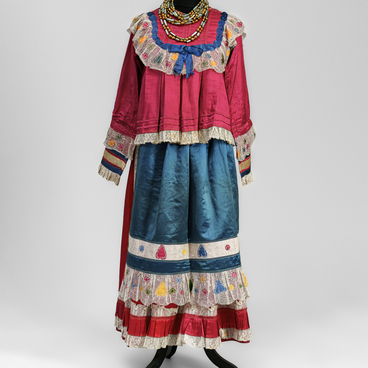The exhibition of the Lipetsk Regional Museum of Local Lore features an exquisite jacket made of dark cherry velvet. This is part of a riding habit — women’s clothing for horseback riding. It belonged to Yekaterina Arkadyevna Vinogradova, a resident of Lipetsk, a teacher, and a nurse practitioner.
The jacket is richly decorated with various elements. The stand-up collar, right panel, and cuffs are trimmed with fine white lace. There are also decorative bows made from satin ribbons that match the jacket and complement the elegant lace. The 16 round buttons on the left panel are lined with silk threads and covered by thin netting that matches the color of the main material. The jacket is slim-waisted. A corset-like fit is created by nine wires sewn along the waistline. The hem of the jacket is elongated and has a cut in the back, with decorative elements at the ends and a large bow made from satin ribbon at the top.
Horseback riding was an integral part of the lives of noble women who not only went riding but also participated in hunting. A riding habit appeared only in the 16th century. Before that, women rode horses wearing dresses. The essential elements of a woman’s riding habit included a wide, long-tailed skirt, tight high-waisted pants, a hat with a veil, and gloves to protect the sensitive skin of the hands. Women rode in a sidesaddle, sitting aside. A special plank was attached to the soft seat for the legs. Over time, the design of the sidesaddle was improved. The upper pommel was added to ensure a more stable support of the right leg. Horseback riding became especially popular in the 1830s. One of the factors was the invention of the lower pommel by Charles Pellier. It followed the curve of the rider’s left leg. This improvement made the sidesaddle safer and made it easier for women to jump over obstacles.





